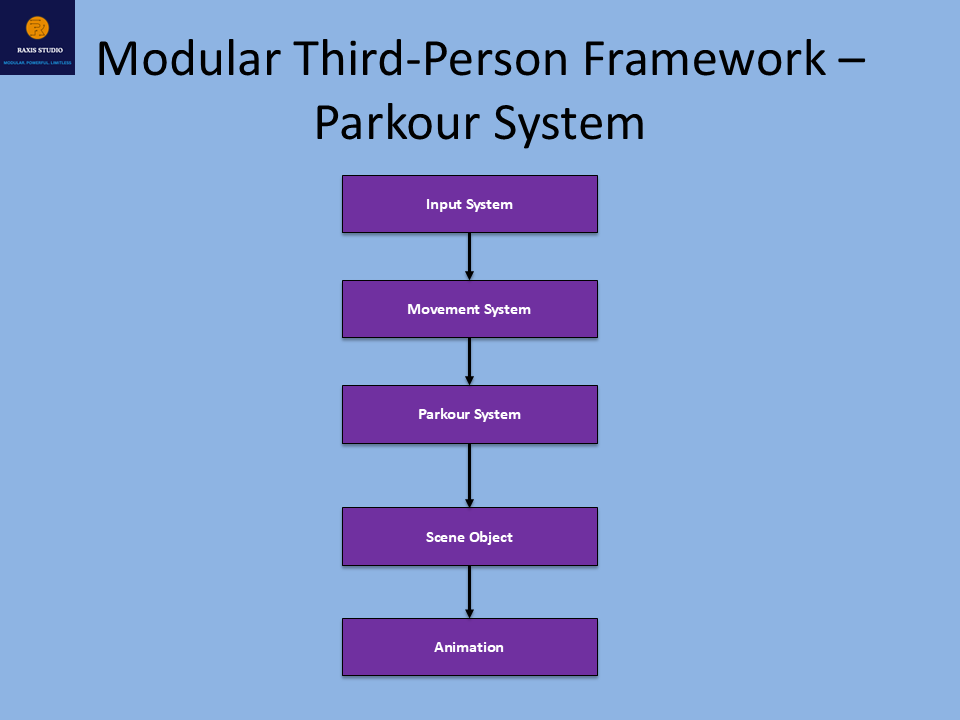Simplifying Parkour in Complex Environments

Intro: The Freedom of Movement Parkour adds freedom, creativity, and style to player movement — but in Unity, it’s also one of the hardest mechanics to get right. Vaulting over an object, jumping over obstacles, or sliding under cover all require precise raycasts, animations, collider adjustments, and IK targeting. The Modular Third-Person Framework makes parkour seamless, modular, and customizable, giving you a complete system with four ready-to-use actions — and the tools to extend it further.
The Challenge: Parkour Without the Headaches Building parkour from scratch usually means:
- Complex raycasts for object detection.
- Constant collider clipping issues.
- Animations that don’t align with the player’s position.
- Hardcoding every action, making new ones painful to add.
- Endless debugging across states and transitions.
And the more objects you add to your scene, the messier it gets.
The Solution – Parkour System in the Framework The framework comes with a complete parkour system that handles both vertical and horizontal actions:
- Vault → smooth vaulting over medium-height objects.
- Small Jump → hop over low obstacles without breaking momentum.
- High Jump → scale taller objects with realistic positioning.
- Slide → duck under obstacles or into low cover with automatic collider adjustments.
Key Features
- Automatic detection → raycasts identify object type and height.
- Smart positioning → player collider adjusts before, during, and after the action.
- Unified input → all parkour actions can share one interact key, with automatic context detection.
- Clean transitions → integrates seamlessly with locomotion and IK systems.
- Customizable offsets → tweak distances and animation targets to fit your game.
- Hand IK on contacts → during vaults, jumps, and slides, the player’s hands align to contact points (e.g., ledges, wall tops). Slide actions intentionally skip hand IK for realism.
- Smooth motion curves → each action uses editable AnimationCurves to control force, timing, and acceleration for fluid motion.
- Extendable actions→ add new parkour moves by:
- Adding the new action in the Enum Interaction list.
- Creating a new ScriptableObject for that action and adjusting its fields.
Proof: Parkour That Just Works Without the framework:
- Player collides awkwardly with objects.
- Animations play but clip through walls.
- Each new obstacle requires custom code.
With the framework:
- Player vaults, jumps, and slides naturally.
- Colliders adapt dynamically.
- IK ensures hands align to ledges and tops during contact.
- Parkour works on any tagged scene object with minimal setup.
Developer-Friendly by Design The Parkour System is built to be scalable and modular:
- Interface-driven → objects just need a ParkourObject script.
- Factory + State Pattern → parkour integrates into the state machine without clutter.
- ScriptableObject configs → configure thresholds, offsets, forces, and curves.
- Collider logic → automatic resizing prevents clipping.
- Event-driven → communicates with animation and IK systems without tight coupling.
- Shared IK targeting pattern → same approach as Utility interactions (doors/elevators), ensuring consistent setup across systems.
- Debug toggles → fine-grained logs for colliders, IK, animations, and detection, controllable through ScriptableObjects.
Use Cases
- Action-adventure games → fluid traversal across varied environments.
- Stealth games → sneak through cover with slides and low jumps.
- Parkour-focused games → chain vaults, jumps, and slides for dynamic momentum.
- Prototyping to production → start with built-in actions, then extend with new moves.
Freedom Without Frustration Parkour should feel natural and exciting, not like a coding nightmare. With the Modular Third-Person Framework, you get four fully functional parkour actions out-of-the-box — plus the freedom to expand with your own.
👉 Get the Modular Third-Person Framework on the Unity Asset Store: Modular Third-Person Framework | Game Toolkits | Unity Asset Store



